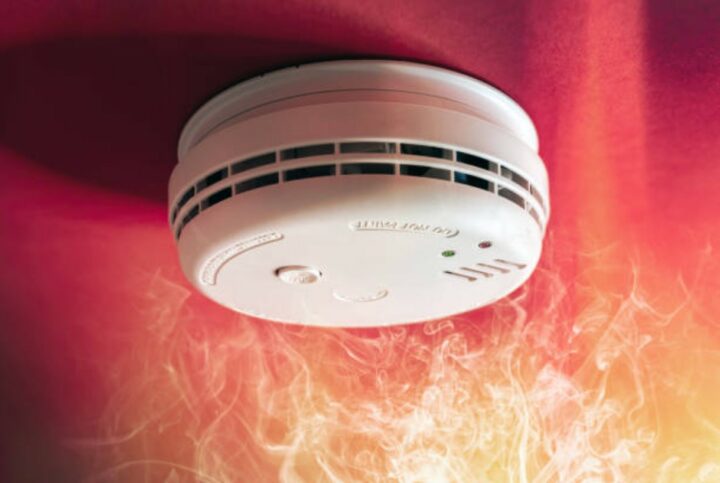 Wireless fire detectors have revolutionized fire safety systems, providing flexibility and convenience without the constraints of wired connections. This article explores how wireless fire detectors operate, the types of sensors they use, the technologies behind their signal transmission, and the power supply that ensures they function reliably.
Wireless fire detectors have revolutionized fire safety systems, providing flexibility and convenience without the constraints of wired connections. This article explores how wireless fire detectors operate, the types of sensors they use, the technologies behind their signal transmission, and the power supply that ensures they function reliably.
Fundamentals of Wireless Fire Detectors
Wireless fire detectors function similarly to their wired counterparts, with one key difference: they communicate without physical connections. Instead of being hardwired into a central control panel, wireless detectors use radio frequency (RF) signals to transmit information, making them highly adaptable to various environments.
These detectors continuously monitor their surroundings for signs of fire like smoke, heat, or gas. Upon detecting an anomaly, they send a signal to the control panel, triggering alarms and other safety protocols. The absence of wires means they can be placed in locations where traditional wired systems would be impractical or disruptive.
Types of Sensors in Wireless Fire Detectors

Wireless fire detectors incorporate various sensor types to detect different fire-related phenomena. The choice of sensor depends on the specific needs of the environment being protected.
Smoke Detectors:
- Photoelectric Sensors: These sensors use light beams to detect smoke particles. When smoke enters the detector, it scatters the light beam, triggering the alarm. Photoelectric sensors are particularly effective at detecting smoldering fires, which produce large amounts of smoke before flames appear.
- Ionization Sensors: These sensors detect smoke using a small amount of radioactive material that ionizes the air inside the detector. When smoke particles enter the chamber, they disrupt the ionization process, triggering the alarm. Ionization sensors are more responsive to fast-flaming fires, which produce smaller smoke particles.
- Photoelectric Sensors: These sensors use light beams to detect smoke particles. When smoke enters the detector, it scatters the light beam, triggering the alarm. Photoelectric sensors are particularly effective at detecting smoldering fires, which produce large amounts of smoke before flames appear.
Heat Detectors:
- Fixed Temperature Sensors: These sensors trigger an alarm when the temperature in a room exceeds a preset threshold, typically around 135°F (57°C). They are often used in environments where smoke detectors may produce false alarms, such as kitchens.
- Fire Sensors: These detect rapid temperature increases, indicating a developing fire. Fire detectors are effective in areas where temperature fluctuations occur, but fires develop quickly.
- Fixed Temperature Sensors: These sensors trigger an alarm when the temperature in a room exceeds a preset threshold, typically around 135°F (57°C). They are often used in environments where smoke detectors may produce false alarms, such as kitchens.
Gas Detectors:
- Carbon Monoxide (CO) Sensors: These sensors detect the presence of CO, a colorless, odorless gas that is a byproduct of combustion. CO sensors are critical in environments where incomplete combustion could occur, such as in industrial settings or areas with gas-powered appliances.
- Carbon Monoxide (CO) Sensors: These sensors detect the presence of CO, a colorless, odorless gas that is a byproduct of combustion. CO sensors are critical in environments where incomplete combustion could occur, such as in industrial settings or areas with gas-powered appliances.
Flame Detectors:
- Infrared (IR) Sensors: Infrared flame detectors identify the specific wavelengths of light emitted by flames. They are highly sensitive and can detect fire, even in smoke or other obscurants.
- Infrared (IR) Sensors: Infrared flame detectors identify the specific wavelengths of light emitted by flames. They are highly sensitive and can detect fire, even in smoke or other obscurants.
Signal Transmission Methods

The core functionality of wireless fire detectors lies in their ability to transmit signals without physical connections. Several technologies facilitate this wireless communication:
Radio Frequency (RF) Technologies:
- Standard RF Communication: Wireless fire detectors use RF signals to communicate with the control panel. These signals are transmitted on dedicated frequencies to avoid interference from other wireless devices, ensuring reliable performance.
- Frequency Hopping Spread Spectrum (FHSS): This technique involves rapidly switching frequencies during transmission, reducing the risk of interference and ensuring secure communication between the detectors and the control panel.
- Standard RF Communication: Wireless fire detectors use RF signals to communicate with the control panel. These signals are transmitted on dedicated frequencies to avoid interference from other wireless devices, ensuring reliable performance.
Mesh Networks:
- Self-Healing Networks: Some advanced wireless fire detection systems use mesh networking, where each detector acts as a node that relays signals to other detectors. If one detector fails or encounters interference, the network automatically reroutes the signal through another path, ensuring continuous communication.
- Self-Healing Networks: Some advanced wireless fire detection systems use mesh networking, where each detector acts as a node that relays signals to other detectors. If one detector fails or encounters interference, the network automatically reroutes the signal through another path, ensuring continuous communication.
Zigbee and Z-Wave Technologies:
- Low-Power Wireless Communication: Zigbee and Z-Wave are common in smart home systems, including wireless fire detectors, due to their low power usage. However, their reliability can be inconsistent, with interference and limited range. For critical applications like fire detection, considering other communication methods or supplementing these protocols with wired systems may be necessary to ensure dependable performance.
- Low-Power Wireless Communication: Zigbee and Z-Wave are common in smart home systems, including wireless fire detectors, due to their low power usage. However, their reliability can be inconsistent, with interference and limited range. For critical applications like fire detection, considering other communication methods or supplementing these protocols with wired systems may be necessary to ensure dependable performance.
The Power Supply and Battery Life

The power supply is critical for wireless fire detectors, which rely on batteries rather than wired connections to function. Ensuring long battery life and reliable operation is essential for maintaining safety.
Battery Types and Life Expectancy:
- Lithium-Ion Batteries: Most wireless fire detectors use lithium-ion batteries known for their long life and stability. These batteries can last 5 to 10 years, depending on usage and conditions, making them a dependable choice for fire detection systems.
- Alkaline Batteries: Some lower-cost wireless detectors use alkaline batteries, generally having a shorter lifespan of 1 to 2 years. Regular maintenance and battery replacement are essential for ensuring these detectors remain operational.
- Lithium-Ion Batteries: Most wireless fire detectors use lithium-ion batteries known for their long life and stability. These batteries can last 5 to 10 years, depending on usage and conditions, making them a dependable choice for fire detection systems.
Low-Battery Alerts:
- Audible and Visual Warnings: Modern wireless fire detectors are equipped with low-battery alerts, such as beeping sounds or flashing lights, to notify users when the battery needs replacement. This ensures the detectors remain functional and don’t fail during an emergency.
- Audible and Visual Warnings: Modern wireless fire detectors are equipped with low-battery alerts, such as beeping sounds or flashing lights, to notify users when the battery needs replacement. This ensures the detectors remain functional and don’t fail during an emergency.
Energy-Saving Technologies:
- Sleep Modes and Power Management: Many wireless fire detectors use power-saving modes when not actively monitoring or transmitting to extend battery life. For instance, detectors might enter a low-power sleep mode and wake up periodically to check for hazards. This approach significantly conserves energy, allowing the batteries to last longer.
- Sleep Modes and Power Management: Many wireless fire detectors use power-saving modes when not actively monitoring or transmitting to extend battery life. For instance, detectors might enter a low-power sleep mode and wake up periodically to check for hazards. This approach significantly conserves energy, allowing the batteries to last longer.
Alternative Power Supply Options:
- 12V Power Supply: Some advanced wireless fire detectors can connect to a 12V power supply as a backup or alternative to batteries. This ensures continuous operation even if battery levels are low or more stable power is preferred for critical environments. This added flexibility enhances reliability and reduces the need for frequent battery checks.
- 12V Power Supply: Some advanced wireless fire detectors can connect to a 12V power supply as a backup or alternative to batteries. This ensures continuous operation even if battery levels are low or more stable power is preferred for critical environments. This added flexibility enhances reliability and reduces the need for frequent battery checks.
Conclusion
Wireless fire detectors significantly advance fire safety, offering flexible, reliable, and scalable solutions for various environments. By leveraging a range of sensors, advanced signal transmission technologies, and energy-efficient power supplies, these detectors provide robust protection without the limitations of wired systems.
Whether in residential, commercial, or industrial settings, wireless fire detectors are essential to modern fire safety strategies. Proper maintenance, including regular battery checks, ensures that these detectors remain ready to protect against potential fire hazards at all times.













